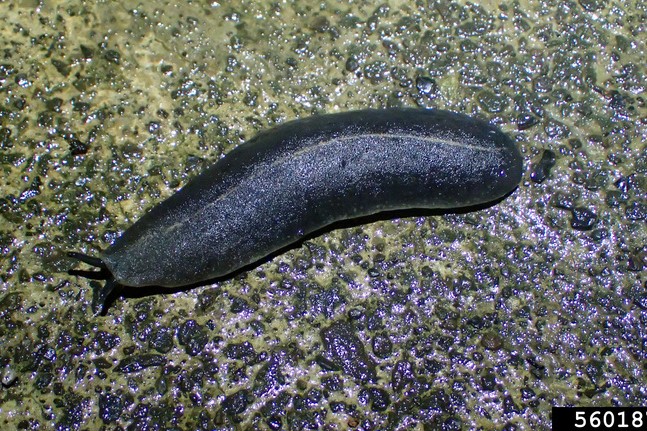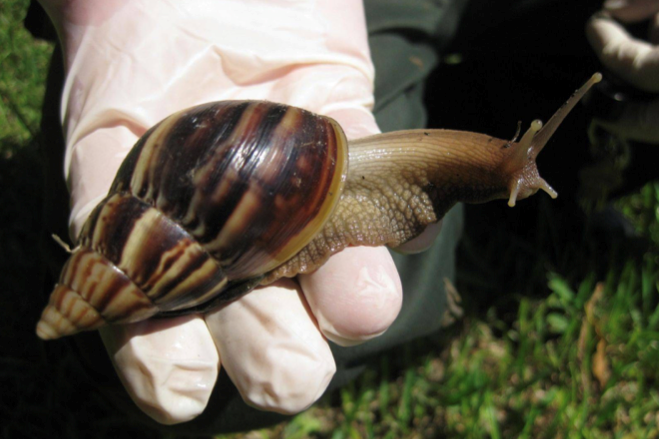Common name: Coconut candang-cadang disease
Scientific name: Coconut cadang-cadang viroid
Status in Hawaii: Not known to be present in Hawaii
The smallest viroid known, cadang-cadang is lethal to coconut and related palms and is capable of destroying vast swaths of palm trees. An estimated 500,000 palms die per year in the Phillipines from the disease.


Impacts
- Affects all commercial cultivars of coconut palms (Cocos nucifera). Can also affect betelnut (Areca catechu), sugar palm (Arenga pinnata), Borassus, gebang palm (Corypha utan), African oil palm (Elaeis guineensis), sago palm (Metroxylon sagu), date palm (Pheonix dactylifera). The natural method of spreading is unknown. Kills coconut trees. No treatment and no resistant cultivars have been found.
- Since 1980, it is estimated that the disease has killed more than 30 million coconut palms.

Identification
- Fruits/nuts: abnormal rounding of the normal triangular distal end and longitudinal scarifications around the equator. Nut production then ceases at 2+ years.
- Inflorescence: spathes reduced in number and size; upon opening emergent tips necrotic, female flowers reduced in number or absent, abscission of male florets.
- Leaves: leaflets on fronds 4-6 from spear show chlorotic non-necrotic spots 1-2 mm across; older fronds show progressive enlargement and coalescence of spots to give a mottled chlorotic general appearance. The spots are yellow/orange.
- Petiole: basal fiber remains attached for some distance up the petiole towards the lowest leaflet, giving a ‘winged’ appearance.
- Whole plant: dwarfing, top of the trunk becomes narrow or pencil-shaped, indicating reduced growth at the meristem.
- Inoculated palms of several other species show mild or severe yellow leaf spotting and stunting.
Symptoms move through 3 stages:
- Stage 1 (lasts 2-4 years): Rounded coconuts, yellow spots on leaves appear.
- Stage 2 (2 years): Inflorescences become necrotic, nut production ceases, new frond production slows down, and leaf spots become larger and more frequent. From a distance, the entire fronds look chlorotic (yellow).
- Stage 3 (5 years): Just before death, spots are so large they begin to merge together, so the whole crown looks yellow/bronze. Very few fronds and the remaining fronds are small.
- The overall time from the first symptom to death is 8 years. If the tree is older (40 years+), it can survive for about 16 years. Usually, palms become naturally infected only after they have reached the age of flowering. In the rare cases where younger palms become infected




Vectors/Commodities
- Contaminated tools and farm equipment.
- Importing coconut germplasm, seed, and pollen from the Philippines.

Distribution
- Philippines

Best Management Practices
- Symptoms are unreliable (looks very similar to nutrient deficiencies, water stress, and storm damage)for detection and take a long time to show. Reliable diagnosis is achievable only by molecular methods.
- Do not import living coconut tissue, such as seedlings, nuts for germination and pollen out of the general cadang-cadang region in the central Philippines.
Other Nursery Pests
PEST PREVENTION TRAINING
An advanced education program for those on the front lines protecting Hawaii from invasive species.
Contact your local Invasive Species Committee to schedule a training for your team. Learn more
This material was made possible, in part, by a Cooperative Agreement from the United States Department of Agriculture’s Animal and Plant Health Inspection Service (APHIS). It may not necessarily express APHIS’ views.
































